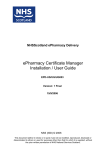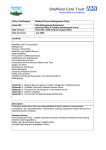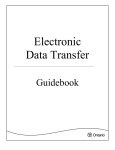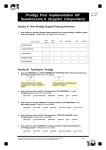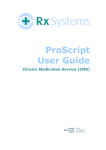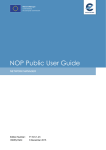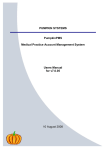Download Chronic Medication Service
Transcript
Chronic Medication Service Frequently Asked Questions Patient Registration Q. Who is eligible to register for CMS? A. To be eligible to register for CMS, a patient must be registered with a GP practice in Scotland, have a long-term medical condition such as asthma, diabetes or heart disease and receive regular prescriptions. In addition, they must not be a resident in a care home setting or a temporary resident in Scotland. Q. So patients in Care Homes are excluded from CMS? A. Yes. Currently care home patients are excluded. Support for patients with long-term conditions residing in care homes is being considered as a separate service. Q. Is it like MAS and only available to patients who are exempt from prescriptions charges? A. No. Any patient with a long-term condition can register for CMS regardless of their exemption (or paying) status. However, the serial prescribing and dispensing stage of CMS is restricted in the initial year to patients who are exempt from prescription charges on the grounds of their age, maternity and medical exemptions. Q. Can a patient register with any community pharmacy for CMS? A. Yes. A patient who is eligible to register for CMS can register with any community pharmacy in Scotland. Q. Can a patient who lives in Scotland but is registered with a GP practice in England register for CMS? A. No, to be eligible for CMS the patient must be registered with a GP practice in Scotland. 1 Q. What information is needed to register a patient for CMS? A. You need to provide the patient’s: Name Gender Address Postcode Date of Birth Exemption Category Community Health Index (CHI) number. All of this data should already be held in the patient’s PMR record. Q. Is there a new form for registering patients for CMS? A. Yes. Your NHS Board will replace the CP2 forms used for MAS with a new dual form for both CMS and MAS. The left-hand side of the form will remain as the CP2 form and the previously blank right-hand side becomes the new CP3 form used for CMS registrations. Q. So I will not have to change paper in my printer for each service? A. No. Your PMR system will know on which side of the form to print, based on the service you are undertaking at that time - registering a patient for either MAS using the CP2 or CMS using the CP3 or recording the outcome of a MAS consultation on a CP2. Q. Who do I contact to get further supplies of the CP2/CP3 forms? A. Your NHS Board will keep supplies of the forms. They will send you an initial batch and then you re-order from the same contact you previously used for CP2 forms. Remember to order in plenty of time, so that you do not run out of forms before you receive a further supply. Q. What do you mean by explicit patient consent? A. Explicit patient consent is required for CMS because it involves different information being shared between healthcare professionals - for example, you will be sending dispensing data back to a GP practice and an end-of-care treatment summary which contains patient related data. Patients must be told about the use of their information and their consent obtained before their information is used in different ways. Patient consent should be informed (i.e. they understand the implications of agreeing to its use) and freely given. Explicit consent means asking a patient to actively express consent - which is best practice. 2 Q. Can a patient transfer to another community pharmacy for CMS? A. Yes. As part of the transfer, the original community pharmacy will be notified of the withdrawal of the patient, as will their GP practice, who will also be notified of the registration at the new community pharmacy. Q. As the GP gets notification of CMS registrations, will they now also get notification of Minor Ailments Service registrations? A. No. MAS is a pharmacy-only service. Q. How will I know if a patient is registered for CMS elsewhere? A. You can request an on-line CMS registration status request to check if a patient is already registered for CMS at another pharmacy. A patient can only be registered with one pharmacy at any one time. If you try and register a patient who is already registered with another pharmacy, then your PMR system will inform you that the patient is already registered elsewhere and you will be prompted to check with the patient that they wish to move their registration. If they do want to move their registration then you can proceed to register them. Their registration will be withdrawn from the original pharmacy and their GP practice notified of the change. Q. Does a patient's CMS registration lapse like a Minor Ailments Service registration can? A. No. CMS registrations do not lapse. Their registration can be withdrawn - for example, if they die or move their registration to another pharmacy - but it will not lapse. Q. Which of the declarations, A, B, C and D on the CP3 form have to be crossed by the patient before signing? A. All of them. If a patient does not want to cross any of the sections, they cannot be considered for CMS. Pharmaceutical Care Planning and the Pharmacy Care Record Q. How do I access the Pharmacy Care Record? A. The Pharmacy Care Record (PCR) is a web-based resource that can be accessed via the computer/s in your pharmacy. Your PMR system supplier will make sure your computer/s are configured to do this. You will also be given a user name and password by your NHS Board. You use these to log on to the PCR. 3 Q. What happens if I forget my password? A. Contact the ePharmacy helpdesk on 0131 275 6600. Q. Do I leave a note of my user name and password for my locums to allow them to log onto PCT in my absence? A. No. You must keep your user name and password confidential - just like the PIN number for one of your bank cards. Work is being progressed to ensure that all locums are given their own user name and password to allow them to access the PCR. There will also be a process for newly qualified pharmacists and those coming to work in Scotland to request a user name and password. Q. Who will provide me with information about how to use the Pharmacy Care Record? A. Your PMR system supplier provides you with information about how to access the PCR from your PMR system. They will also advise you on how to upload any relevant patient data from your PMR system to PCR. NES Pharmacy is producing a user manual for PCR and this will be sent to each community pharmacy. Q. What do I do if I need help with the Pharmacy Care Record or have to report a problem with it? A. You should contact the ePharmacy Helpdesk in the first instance on 0131 275 6600 or email at [email protected]. Q. Will I have to develop a pharmaceutical care plan for every patient that I register for CMS? A. No. You should identify and prioritise individual patients who may be at risk of suboptimal therapeutic management, suffering side effects or showing signs of poor compliance and develop a pharmaceutical care plan for them in the first instance. This allows you to introduce CMS in a planned way, using your time effectively by initially targeting those patients most in need of your support. Q. How will I identify these patients? A. You must undertake a risk assessment of any patient that you register for CMS within the first three months of registering them for the service. This risk assessment helps you to identify and prioritise those most in need of your support. To assist you with this, the PCR has a risk assessment tool which you can use to develop an overall risk profile for each of the patients you have registered. Q. What is the time period for undertaking a Priority Profile after registration? A. Three months from the date of registration. 4 Q. Is there any time frame for commencing a Care Plan after completing the Priority Profile? A. Where a pharmacist identifies a patient who would benefit from a care plan and prioritised accordingly, then they should start as soon as is possible or feasible after completing the risk assessment. Pharmacists should bear in mind that this may be driven by when they next expect to see the patient which is likely to be linked to a dispensing episode. Not every patient registered for CMS and who has had a pharmaceutical assessment will require a care plan. Q. What happens if the pharmacist starts the day in one pharmacy but moves to a second pharmacy at some point during the day? A. There is no option or need for a pharmacist to disassociate themselves from a pharmacy on the Pharmacy Care Record. If a pharmacist first associates themselves in Pharmacy A and operates there for a time and then goes to Pharmacy B later the same day, the act of associating themselves at Pharmacy B will automatically remove the association at Pharmacy A. All associations for all pharmacists are removed automatically at 1am the following morning. Q. Can more than one pharmacist be associated to the Pharmacy Care Record system in the same pharmacy at the same time? A. Yes, multiple pharmacists can associate themselves at the same pharmacy at the same time. However, the pharmacist that is using the PCR should ensure that they are logged in on that PC with their own user details as audit records are kept. A pharmacist will be automatically logged out of the Pharmacy Care Record system after 30 minutes of inactivity. Q. If the Pharmaceutical Care Plan is being used to enhance the quality of the overall care of patients, how is it being shared with the GP? A. The GP is responsible for the overall medical care of the patient. CMS formalises the role of the pharmacist in the pharmaceutical care of the patient which feeds into their overall medical care. There may be some elements which the pharmacist and the patient resolve themselves; others may require the involvement of additional members of the health care team. How much is shared with the GP will depend on the issue/action. The plan is to share any information with the GP via the end-of-care Treatment Summary where there is a serial prescription. Otherwise, pharmacists should use normal routes of communication for any actions related to the pharmaceutical care planning process. Q. How will CMS work with locums if it requires a named pharmacist? A. CMS is not delivered by a named pharmacist. The Pharmacy Care Record allows a named pharmacist to be recorded against a care plan in order to provide the patient and other pharmacists with the name of the pharmacist who is taking overall responsibility for their care plan as this supports continuity of care. As long as a locum has a username and password for the PCR, they will be able to contribute to CMS through the care planning process. 5 Q. If an Over The Counter item is entered onto the PCR, will this be overwritten when a data upload from the PMR is done? A. No. It will remain in the history. Q. Can a pharmacist print the care plan from the PCR to give to the patient? A. Yes. Q. If the pharmacist has completed a care plan for a patient and they are rejected for CMS by their GP, what happens to the care plan? A. GP activity does not impact on the registration and care planning stages of CMS – only serial prescribing and dispensing. The GP may consider a patient is not suitable for a serial prescription but this does not prevent the pharmacist developing a care plan for the patient. Serial Prescribing and Dispensing Q. Can any patient registered for CMS be given a serial prescription? A. No. It is not a requirement of CMS that every patient is provided with a serial prescription/s. In addition, in the first year of CMS, only people with age-related or medical exemptions may be given a serial prescription. This is because serial dispensing relies mainly on electronic claim messages and this means that the regular Counter Fraud Service (CFS) checks cannot be undertaken because there is no patient signature associated with the electronic claim. This position will be reviewed in 2011. Q. Who decides on the dispensing intervals for a serial prescription? A. The patient's GP decides on the dispensing intervals. Q. Can controlled drugs be provided on a serial prescription for CMS? A. Only controlled drugs listed in Schedule 5 of the Misuse of Drugs Regulations 2001 can be prescribed on a serial prescription. No other controlled drugs are allowed. In addition, cytotoxic medicines such as methotrexate are not prescribable on a serial prescription. Q. Can a GP amend a CMS serial prescription as they can with AMS prescriptions? A. No. A GP can not amend a CMS serial prescription. They can only cancel an item on a serial prescription. Therefore, if a GP wishes to change an item, for example increase or 6 decrease the strength of the medication then they will have to cancel the original CMS item and produce a new prescription. This can be a standard GP10 prescription or a serial prescription depending on the GP's clinical opinion. Q. How will a pharmacy know if the GP has cancelled an item on a CMS prescription? A. The next time they go to dispense an item from the serial prescription, their PMR will check with the ePharmacy Message Store (ePMS) for any cancellations from the GP. Q. What pharmacy endorsements should be put onto a CMS serial prescription? A. None. Only electronic endorsements are required for CMS. Q. When should the patient or representative be asked to complete the reverse of the GP10 form? A. At the time of the last dispensing episode as the signature on the form is only valid for three months. Q. Where do I find the CMS disease specific protocols? A. The disease specific protocols will be available in the Pharmacy Care Record. Q. What happens if a patient requests a dispensing episode slightly earlier or later than the GP has outlined on the serial prescription, for example if the prescription states dispense every 56 days and the patient comes in a week earlier than expected? A. You can use your professional judgement, within reason, to decide on the appropriateness of any request for a dispensing episode, whether earlier or later. It is not mandatory that you only supply an episode at rigid 56 days intervals. It is worth noting that patients who comply well with medication frequently order their supplies slightly earlier to ensure that they do not run short. You should monitor regular late requests for poor compliance. Q. How can you identify a CMS prescription? A. CMS 24 (or 48) weeks is printed in the bottom left-hand corner of the GP10. The dispensing interval is identified for each item prescribed and the Unique Prescription Number (UPN) begins with a ‘K’. 7 Q. If a patient is exempt from prescription charges on age or medical grounds at the time of receiving a serial prescription and their exemption status changes before the end of the prescriptions term, should they be charged for the medication from the point they were no longer exempt? A. No. The exemption will carry across for any dispensing episodes from that serial prescription. Q. What would happen if the paper GP10 was submitted before the end of the treatment period? A. The pharmacist should no longer undertake any dispensing episodes as they will no longer be in possession of the signed prescription which is the legal entity. Q. What would happen if the paper GP10 is never submitted by the community pharmacy? A. The Directions state that the pharmacist must submit a serial prescription within 3 months of the final dispensing episode (or completion or expiry of the prescription). Q. What would happen if a patient never returned for subsequent instalments from a serial prescription and the pharmacist was unsure why they had not returned? If the pharmacist waits until the end of the medication term before submitting the GP10, they may be out with the 3 month guideline for paper submission. A. If the patient has not returned for two concurrent 8 week dispensing episodes then the pharmacist should complete the paper prescription form and send it to PSD. They should also contact the patient’s GP practice to inform them of the issue and their action. If the patient has moved into a Care Home or is deceased, the CHI database will pick this up and their registration will be withdrawn from the pharmacy. If the patient has registered elsewhere, they will also be withdrawn form the original pharmacy. The guidance that states serial prescriptions should be submitted within 3 months of having been dispensed in full, expired, completed or cancelled is there to ensure that pharmacists send the paper forms into PSD to allow any Counter Fraud Service (CFS) checks to take place. Q. Is there any way a pharmacist can do an ‘ad-hoc’ check on GP cancellations for serial prescriptions, particularly if they are working in advance to help manage their workload? A. GPs should still inform patients and pharmacists of any changes to a serial prescription (they should not rely on technology solutions alone and CMS means they actually know which pharmacy a patient is registered with and therefore who to contact). Some PMR systems already support a second scan prior to issuing an AMS / CMS prescription – linked both to claiming and allowing such checks to take place. 8 Q. What would happen if a patient lost their medication which had been issued against a serial prescription? Can the pharmacist make another supply from the serial prescription, even though this would contradict the dispensing interval outlined by the GP? A. The pharmacist can make another supply from the serial prescription if, in their clinical/professional opinion, that is an appropriate action. The PMR may warn of an early request but the pharmacist can override this. However, this does mean that the serial prescription will be dispensed in full one cycle earlier than expected and the pharmacist should use the message facility in the End of Care Treatment summary to record the reason for the early repeat request. Of course, an alternative option would be for the pharmacist to use the Unscheduled Care PGD and CPUS form to make a supply; this will keep the serial prescription running in order. Q. Currently, if a patient is exempt from prescription charges on two grounds, e.g. income support and medical exemption, they sometimes do not apply for their medical exemption certificate as they can cross the ‘Income Support’ box on the reverse of the GP10. If these patients registered for CMS, would they now have to apply for their EC92 certificate before they would be eligible for a serial prescription? A. Patient Registration Services use the exemption category in an electronic registration message to flag a patient who is eligible for serial prescriptions (currently age or medical exemption) and this is then used to trigger the release of the electronic CMS registration notification message to a GP practice. Therefore, if the patient has not applied for a medical exemption certificate and has ticked the ‘income support ‘ box which is subsequently what is recorded in the Pharmacy PMR, then the patient will be classed as not eligible for a serial prescription and the GP practice will not receive the registration notification message. So, whilst they can still register for CMS at the pharmacy and receive the assessment and possibly a care plan if appropriate, to be eligible for a serial prescription they will require an EC92 certificate. Q. If a CMS registered patient collects their serial prescription from their surgery, what would happen if they try to get it dispensed at a pharmacy which they are not registered at? A. A serial prescription has to be dispensed in the community pharmacy where the patient is registered so it can only be pulled down and dispensed at the pharmacy which holds their registration. However, the pharmacist in the pharmacy where the patient has presented the serial prescription can register them for CMS at that pharmacy and then dispense the serial prescription. The pharmacist would have to confirm with the patient that they wished to move their registration. Registering at the new pharmacy will withdraw their registration at the previous pharmacy and allow the second pharmacy to dispense the serial prescription. This would also mean that if there were any remaining items on an outstanding serial prescription at the original pharmacy, those items could no longer be dispensed – because the patient is no longer registered there. [Note: the original pharmacy can still send any outstanding CMS claims for the patient.] Therefore, the serial prescription is not solely ‘linked’ to the pharmacy with the original registration. 9










